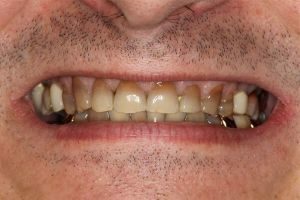 By tetracycline teeth is understood a phenomenon in which the enamel loses its natural color, acquiring brown, yellow-gray, orange, brown, "dirty" and other shades.
By tetracycline teeth is understood a phenomenon in which the enamel loses its natural color, acquiring brown, yellow-gray, orange, brown, "dirty" and other shades.
It is quite difficult to eliminate this defect. Cure with it completely can not bleaching procedures, nor toothpastes with abrasive composition. The problem arises from an increase in the level of tetracycline in the body.
Content
- general understanding of the problems
- What affects the color of the teeth
- nature of clinical
- diagnostic criteria and methods
- treatments and whitening
- remineralizing therapy
- Application ftorlaka
- whitening procedures
- Prevention and consequences
general understanding of the problems
Tetracycline is a part ofmany drugs that have a wide range of effects. It is this substance that penetrates the human body that can change the color of the enamel. The drug is characterized by the ability to bind to calcium during the mineralization, resulting in deterioration of the teeth.
The disease is one of the specific dental pathologies. Tetracycline teeth is one of the varieties of enamel hypoplasia.
The course of the disease is characterized by the absence of carious phenomena. The peculiarity of this pathology is that it develops exclusively in the tissues that have not yet formed. Therefore, pregnant women and children are at risk.
In this disease, the color changes the entire enamel, located both in front and inside the mouth. Pathology develops only against the background of active treatment, conducted by taking medications based on tetracycline. This substance is deposited in the rudiments of enamel, dentin and bone structure of the fetus.
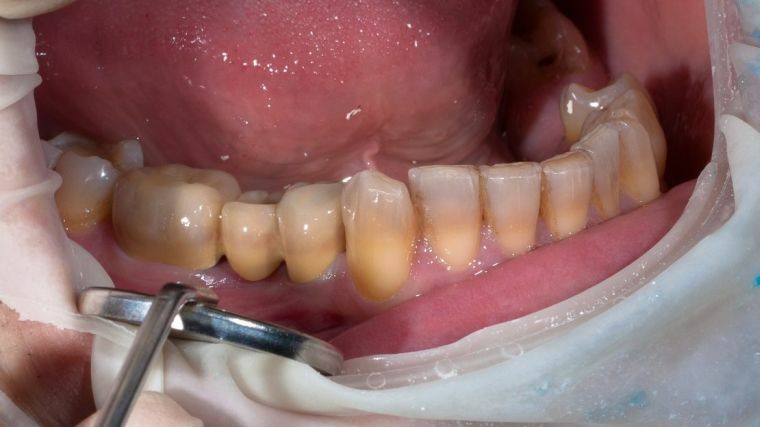
Most often, the color of the part of the tooth that was formed simultaneously with tetracycline treatment:
- if the therapy was performed during pregnancy, the infant's future teeth are affected;
- when the drug is prescribed to a child older than 6 months, the lesions will be visible on permanent teeth.
Over time, the shade of damaged enamel can change under the influence of external factors. For example, the color of teeth can affect food colors.
It was noted above that tetracycline dyeing of teeth appears under the condition that if children or pregnant women take the same antibiotic for treatment of certain diseases. Usually the discoloration of enamel occurs with the consumption of large doses of this substance.
Tetracycline is usually prescribed for the treatment of: 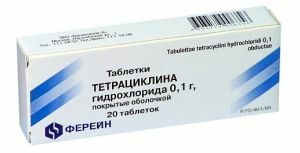
- skin rashes of various types;
- pneumonia;
- peptic ulcer disease;
- cholera.
Dental tissue under normal conditions is formed up to 12 years.
This is why antibiotics of the tetracycline are contraindicated for admission to pregnant and young children. In cases where the need for the use of such drugs is allowed( for example, the disease can not be treated in other ways), the doctor will necessarily inform the patient of the possible consequences.
It is important to note that taking this substance and preparations on its basis does not provoke the development of carious processes and does not cause pain.
The substance in small quantities can only change the color of the enamel. However, in view of the fact that tetracycline disrupts the formation of dental tissue, with the active use of such antibiotics, the structure of the enamel will be abnormal.
What affects the color of the teeth
Depending on the dosage of antibiotics given to the patient, his teeth can acquire one of the following shades:
- yellow or lemon;
- brown;
- gray;
- is orange;
- combination of brown with yellow or orange;
- brown;
- is dark gray.
However, not only the dosage of the drug affects the state of tooth enamel. Its color varies under the influence of many factors, among which one can distinguish:
- individual characteristics of a person;
- over time;
- consumption of food additives and dyes;
- sunlight;
- allergic reactions.
Tetracycline spots are often a cosmetic defect, without causing significant damage to the body.
Nature of the clinical picture
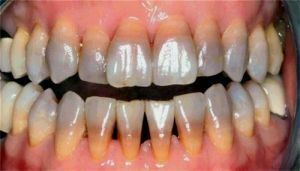 The main symptom is the discoloration of the enamel. Over time, as indicated above, the change in its hue and the intensity of this process can vary under the influence of external factors.
The main symptom is the discoloration of the enamel. Over time, as indicated above, the change in its hue and the intensity of this process can vary under the influence of external factors.
The whole tooth is not usually colored, but its individual part. Initially the discoloration of the enamel occurs:
- in the cervical part;
- on the contours;
- on folds of angular teeth.
With small doses of the drug taken, the enamel acquires a yellow or lemon tinge. But even with a significant excess of the level of the substance in the blood, the color changes on separate parts of the tooth. The difference is only in the color of the enamel: the darker it is, the more tetracycline the patient took.
Diagnostic criteria and methodologies
Diagnosis of the disease is based on information obtained:
- during the history;
- during the clinical examination of the patient.
If you suspect a tetracycline staining, the doctor will determine the duration of the course of taking and dosage of antibiotics. During dental sounding for the presence of this disease indicates a rough surface of the enamel. But when touching the damaged parts of the tooth, the patient does not experience pain.
Additional information is obtained during the lumen of the affected enamel with ultraviolet rays. On the pathology indicates the effect of fluorescence. However, this phenomenon occurs when the enamel has a light tint. With a significant damage to the dental tissue, the latter loses its ability to glow.
Diagnosis is performed to differentiate the disease in question with other pathologies: 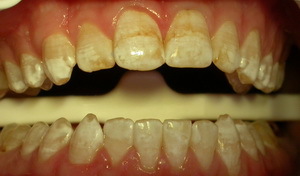
- fluorosis;
- congenital color disorder of enamel caused by Rh-conflict;
- hereditary malformations of enamel and dentin.
To differentiate tetracycline teeth with other pathologies, an orthopantomogram is used, which in this case does not reveal any disturbances in the area of the dentin and the root of the tooth.
Methods of treatment and bleaching
Treatment of tetracycline teeth is carried out in several stages.
The first thing to do is to abandon all medications - provocateurs.
Remineralizing therapy
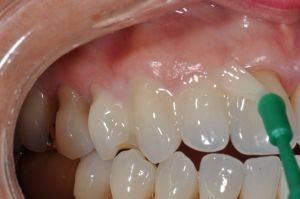 During therapy, measures are being taken to strengthen bone tissue. To do this, the body is saturated with fluoride, phosphorus and calcium through specialized procedures.
During therapy, measures are being taken to strengthen bone tissue. To do this, the body is saturated with fluoride, phosphorus and calcium through specialized procedures.
Before the beginning of remineralizing procedures, stones and bacterial plaque are removed from the surface of the teeth. To restore the damaged structure, it will take 15-20 sessions, which are conducted at least every two days.
Application of fluorine lacquer
Ftorlac is applied to strengthen damaged enamel. The substance allows to preserve the natural color of the teeth for a longer period of time and to eliminate the negative influence of the external environment.
Bleaching procedures
After the tetracycline teeth have been strengthened and coated with fluorine-containing substances, they are bleached by means of a laser or a Zoom 3.
The choice in favor of a particular method is based on the patient's preferences and capabilities, as well as the therapeutic indications. 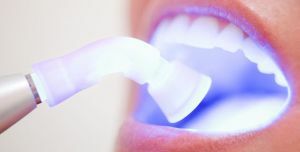 Procedures allow you to whiten the tooth for 10-12 shades.
Procedures allow you to whiten the tooth for 10-12 shades.
In cases where these methods do not help to eliminate the cosmetic defect, restoration of damaged dental tissue with composites or ceramic veneers is carried out.
These procedures are a partial restoration of the affected tissue through prosthetics. Veneers allow you to hide cosmetic defects, cracks and much more.
At home, special pencils, strips, toothpastes and gels are used to whiten tetracycline teeth. But it is worthwhile to understand that these remedies do not help to completely eliminate the cosmetic defect. They will only whiten their teeth for 1-2 shades.
In addition, at home, a 5% calcium gluconate solution is used to treat tetracycline spots. This drug is recommended for young children.
Prevention and consequences of
Adult tetracycline coloration can be prevented. It is they who decide whether to use the medicine for therapeutic purposes or to refuse the substance in favor of other drugs. There are no other methods of prevention.
The course of the disease does not lead to complications. Tetracycline teeth are, rather, a cosmetic defect, rather than a pathology dangerous for human health.
